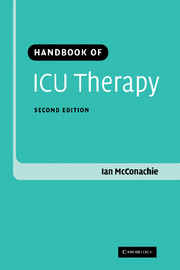Book contents
- Frontmatter
- Contents
- List of contributors
- Preface
- Part I Basic principles
- 1 Cardiac function, monitoring, oxygen transport
- 2 Shock
- 3 Oxygen therapy
- 4 Central venous access
- 5 Fluid therapy in ICU
- 6 Anaemia and blood transfusion
- 7 Nutrition
- 8 Non-invasive mechanical ventilation
- 9 Principles of IPPV
- 10 Modes of ventilation and ventilatory strategies
- 11 Weaning and tracheostomy
- 12 Vasoactive drugs
- 13 Infection and infection control
- 14 Sedation, analgesia and neuromuscular blockade
- 15 Continuous renal replacement therapy
- 16 Withholding and withdrawing therapy in the ICU
- Part II Specific problems
- Index
5 - Fluid therapy in ICU
Published online by Cambridge University Press: 24 August 2009
- Frontmatter
- Contents
- List of contributors
- Preface
- Part I Basic principles
- 1 Cardiac function, monitoring, oxygen transport
- 2 Shock
- 3 Oxygen therapy
- 4 Central venous access
- 5 Fluid therapy in ICU
- 6 Anaemia and blood transfusion
- 7 Nutrition
- 8 Non-invasive mechanical ventilation
- 9 Principles of IPPV
- 10 Modes of ventilation and ventilatory strategies
- 11 Weaning and tracheostomy
- 12 Vasoactive drugs
- 13 Infection and infection control
- 14 Sedation, analgesia and neuromuscular blockade
- 15 Continuous renal replacement therapy
- 16 Withholding and withdrawing therapy in the ICU
- Part II Specific problems
- Index
Summary
Fluid therapy in ICU
Maintenance of normal hydration and electrolyte composition is essential in intensive care unit (ICU) patients.
“Volume loading” is an important principle of cardiovascular management and is the cornerstone of management of surgical and trauma patients.
Conversely, overhydration may be a factor in poor outcome from ICU care.
Body fluid compartments
Water comprises approximately 60% of body weight. Approximately two-thirds of this is intracellular fluid and the remainder extracellular fluid. Extracellular fluid is mainly interstitial fluid with only 15–20% consisting of blood and plasma. In critically ill patients there are often considerable increases in extracellular fluid.
In order to understand the principles of fluid therapy one must be aware of which body fluid compartment one is wishing to maintain or resuscitate, for example:
Intracellular space — deficits mainly H2O.
Interstitial space — deficits H2O and electrolytes.
Intravascular space — deficits of plasma volume and/or red blood cell (RBC).
Surgical and trauma patients may suffer losses of so-called “third space” fluids (called because it represents a third extracellular space) due to tissue fluid sequestration of interstitial fluid (i.e. H2O and electrolytes).
Fluid therapy involves the use of the following:
Crystalloids
H2O with electrolytes approximating the composition and osmolality of plasma.
Crystalloids redistribute through the extracellular fluids and, therefore, only about 20% of the volume administered will remain in the intravascular space.
[…]
- Type
- Chapter
- Information
- Handbook of ICU Therapy , pp. 52 - 63Publisher: Cambridge University PressPrint publication year: 2006



